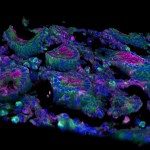Link to Pubmed [PMID] – 29328787
Annu. Rev. Immunol. 2018 Jan;
Retroviruses are genome invaders that have shared a long history of coevolution with vertebrates and their immune system. Found endogenously in genomes as traces of past invasions, retroviruses are also considerable threats to human health when they exist as exogenous viruses such as HIV. The immune response to retroviruses is engaged by germline-encoded sensors of innate immunity that recognize viral components and damage induced by the infection. This response develops with the induction of antiviral effectors and launching of the clonal adaptive immune response, which can contribute to protective immunity. However, retroviruses efficiently evade the immune response, owing to their rapid evolution. The failure of specialized immune cells to respond, a form of neglect, may also contribute to inadequate antiretroviral immune responses. Here, we discuss the mechanisms by which immune responses to retroviruses are mounted at the molecular, cellular, and organismal levels. We also discuss how intrinsic, innate, and adaptive immunity may cooperate or conflict during the generation of immune responses. Expected final online publication date for the Annual Review of Immunology Volume 36 is April 26, 2018. Please see http://www.annualreviews.org/page/journal/pubdates for revised estimates.


